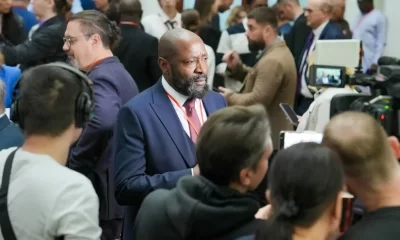Forgotten Dairies
Expediency Of Rethinking Our Fears Over AI As It Is Not Replacing Humanity -By Isaac Asabor
The expediency of rethinking our fears cannot be overstated. The world cannot afford to be paralyzed by myths and misinformation about AI. We must be proactive, curious, and ethical. We must lead the change, not chase it. Because at the end of the day, no machine can replicate what makes us human, our stories, our struggles, and our spirit.

From the moment fire was discovered, to the invention of the wheel, and much later the printing press, the industrial engine, and now artificial intelligence (AI), every technological advancement has had two things in common: promise and panic. And right now, we are in the thick of the panic phase. All around the world, from classrooms to boardrooms, newsrooms to factory floors, there is a growing unease about AI.
As a journalist, I am witnessing this fear play out firsthand. Many colleagues are apprehensive that AI will take their jobs, that machines will write the news, conduct interviews, fact-check, and edit content faster and more efficiently than any human ever could. But in the noise of these anxieties, we risk missing a critical truth: AI is not here to replace humanity, it is here to assist it.
It is therefore expedient, not just advisable, that we rethink our fears over AI. The time to act is now. Instead of burying our heads in the sand or waging a misguided war against technological progress, we must embrace it, understand it, shape it, and wield it as a tool for human advancement.
To recall at this juncture that it is a familiar pattern of fear, it is expedient to opine that history is littered with examples of society recoiling in fear at the dawn of technological evolution. When the printing press emerged in the 15th century, many feared it would spread heresy and destroy the oral traditions. When the industrial revolution mechanized labor, workers rioted and destroyed machines, fearing obsolescence. In the late 20th century, the internet was regarded with suspicion, it would “ruin communication,” they said.
Fast forward to today: the internet is now the backbone of modern civilization. It has enhanced communication, education, trade, and governance. Yes, it came with problems, fake news, cybercrime, digital addiction, but none so severe that humans have not worked to address them.
AI is no different. The problem is not the tool; it is how we choose to use it, or fear it. So at this juncture it is expedient to ask, “Is AI in Journalism a threat or opportunity?” To answer the foregoing question, it is germane to bring it closer to home, the journalism profession. The alarm bells ringing across newsrooms in Nigeria are not unfounded. This is as AI can write summaries, generate headlines, transcribe interviews, and even write simple news stories. It is fast, efficient, tireless, and always available.
But here is the thing: journalism is not merely about writing, it is about judgment, empathy, accountability, and ethics. An AI model cannot investigate corruption with the moral determination of a human reporter. It cannot sit in a courtroom and notice the subtle facial reaction of a judge. It cannot conduct a sensitive interview with a grieving parent, nor understand the cultural implications of a political statement.
What AI can do, and does well, is assist. It can lighten the workload, handle repetitive tasks, and process large datasets in seconds. It can help journalists fact-check claims faster, generate initial drafts, and translate languages instantly. In essence, it can give journalists more time to do what only humans can do, tell deeply human stories.
Given the foregoing backdrop, it can then be asked, “How can journalists ethically integrate AI?” To integrate AI ethically, journalists must operate with transparency, oversight, and accountability. For example, always disclose when AI is used to write or edit content. In a similar vein, use AI tools as assistants, not final arbiters of truth and ensure human editors review AI-generated content for accuracy, context, and sensitivity. Most importantly, avoid using AI to fabricate quotes, create misleading images, or mimic people’s voices without consent.
Also, media houses must establish clear editorial guidelines for AI use, just like there are for sources, quotes, and conflicts of interest.
Again, it is germane to ask, “What new roles might AI create in journalism?” Contrary to fears, AI will not kill journalism, rather, it will transform it, and create new roles, such as: AI Literacy Editors, who would no doubt be Journalists trained to guide newsrooms on how to ethically use AI tools. Data Journalists, who would be reporters who analyze and visualize large sets of data with AI assistance. Prompt Engineers, who would invariably be specialists who design effective prompts to generate accurate and ethical AI outputs.
Also in the same vein, AI Ethics Correspondents, who would be reporters focused on covering the ethical and societal impacts of emerging technologies, and Multimedia Personalization Editors, who would be professionals who use AI insights to tailor content distribution to diverse audiences without compromising journalistic integrity. These are not replacements. These are evolutions.
As matter of fact, the world must embrace AI, and not fear it as an emerging technology. This is as fear stems from ignorance, and the best antidote to ignorance is education. If we fear AI, it is often because we do not understand how it works. That is why governments, institutions, and media organizations must urgently invest in digital literacy. Everyone, from students to CEOs, must be equipped to understand how to interact with AI responsibly.
In fact, instead of seeing AI as a monster lurking in the shadows, let us see it as a mirror: it reflects our intent. If we approach it with malice, it can be weaponized. But if we approach it with wisdom, it can be revolutionary.
We must also remember that behind every AI model are human developers. That means AI is not autonomous in purpose, it follows human instruction. The ethical boundaries and moral compass must come from us.
The greatest threat is not AI replacing us, it is us refusing to adapt. Technology has never waited for those unwilling to evolve. Those who adapt will shape the future; those who don’t will be left behind.
Instead of journalists asking, “Will AI take my job?” a better question would be, “How can I use AI to do my job better?” Instead of teachers asking, “Will AI replace classrooms?” let’s ask, “How can AI personalize learning for different students?”
Instead of leaders asking, “Can AI govern?” they should ask, “How can AI improve transparency, efficiency, and service delivery?”
The real winners will be those who learn to collaborate with the machine, not compete with it.
In conclusion, it is expedient for us to reframe our collective fear over the adoption of AI, and rewrite the future. This is as the rise of AI is not the fall of man. It is the dawn of a new kind of partnership, one where human creativity, ethics, and empathy guide intelligent tools toward better outcomes for society.
The expediency of rethinking our fears cannot be overstated. The world cannot afford to be paralyzed by myths and misinformation about AI. We must be proactive, curious, and ethical. We must lead the change, not chase it. Because at the end of the day, no machine can replicate what makes us human, our stories, our struggles, and our spirit.
























